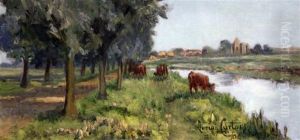Mary Henrietta Dering Curtois Paintings
Mary Henrietta Dering Curtois, born in 1819, is not widely known in the annals of art history, and thus, detailed biographical information about her is limited. She was a British artist who lived during the Victorian era, a period characterized by its strict social norms and burgeoning cultural productions. Women artists of this time often faced significant challenges due to societal expectations and limited opportunities for professional training and exhibition.
Mary Henrietta Dering Curtois's life as an artist would have unfolded within this context, and any artistic education she received may have been private or through informal channels, which was typical for women of her status and time. The Victorian era saw a slight improvement in the recognition of female artists, with the emergence of art schools that admitted women and the increasing acceptability of women participating in the arts, albeit still within the constraints of acceptable 'feminine' subjects and styles.
There is little record of Curtois's specific contributions to art, such as exhibitions or memberships in artistic societies, which were crucial for an artist's reputation and legacy at the time. Her death in 1898 would have marked the end of a life span that witnessed significant changes in the art world, such as the rise of the Pre-Raphaelite Brotherhood and the beginnings of Impressionism.
Without concrete information on her oeuvre or the extent of her involvement in the art community, Mary Henrietta Dering Curtois remains a rather obscure figure. Her legacy, like that of many women artists of her era, may have been overlooked or under-documented in historical records. However, the growing interest in rediscovering and reevaluating the contributions of women to art history may eventually shed more light on her life and work.
